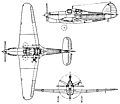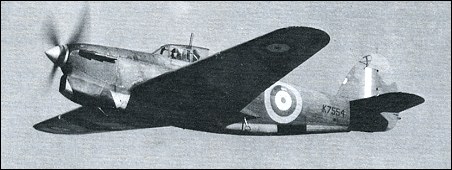|
| The Henley was designed as a two-seat-high-performance light bomber. The prototype first flew in March 1937. Despite its promise, its role was changed to that of target towing. Four hundred were ordered, but only 100 Merlin II and 100 Merlin III-engined Henleys were built at the Gloster works. According to Hawker records two Henleys were used as engine test beds for Vulture and Griffon engines and one was tropicalised.
| ENGINE | 1 x Rolls-Royce Merlin II, 768kW |
| WEIGHTS |
| Take-off weight | 3845 kg | 8477 lb |
| Empty weight | 2725 kg | 6008 lb |
| DIMENSIONS |
| Wingspan | 14.59 m | 48 ft 10 in |
| Length | 11.1 m | 36 ft 5 in |
| Height | 4.46 m | 15 ft 8 in |
| Wing area | 31.77 m2 | 341.97 sq ft |
| PERFORMANCE |
| Max. speed | 438 km/h | 272 mph |
| Ceiling | 8230 m | 27000 ft |
| Range | 1529 km | 950 miles |
 | A three-view drawing (1262 x 1096) |
| andrew lewis, e-mail, 17.06.2016 15:06 i have in my possession the wooden propeller from the winch any ideas where best to advertise it for sale
cheers
Andrew reply | | Andres Erdos, e-mail, 16.08.2012 17:35 The Henley's cantilever fabric-covered monoplane wing was mid-set, retractable tailwheel type landing gear was selected, and accommodation provided for a pilot and observer /air gunner, which differed from the Hurricane's single-seat accommodation.
Although construction of a Henley prototype began as early as mid-1935, with all priorities going to Hurricane development it was not until 10 March 1937 that it was first flown, powered by a Merlin "F" engine; shortly after the competing Fairey P.4 /34. Subsequently the aircraft was refitted with light alloy stressed-skin wings and a Merlin I engine, and further test flights confirmed the excellence of its overall performance. However, the Air Ministry had by this point decided that it no longer required a light bomber, and the Henley was thus re-designated as a target tug. Henley production was subcontracted to Gloster Aircraft, and 200 were ordered into production. The second prototype was fitted with a propeller-driven winch to haul in the drogue cable after air-to-air firing sorties, in recognition of its new role, and was first flown on 26 May 1938. reply | | bombardier, e-mail, 22.05.2011 12:51 The Henley fitted with a R-R Vulture or a Griffon and with 20mm cannons and armour would have been the best attack aircraft of the war.Heavily armed,armoured to survive ground fire and not too fast in order to allow effective aiming. reply | | John Holt, e-mail, 31.07.2009 18:21 Can anyone supply me with the manufacterers model number for the Henley? reply | |
| | J, e-mail, 29.07.2008 02:17 In Hawker Aircraft Since 1920 (Putnam's British Aircraft series )by Francis K Mason Hawker book there are photo's of the above mentioned test beds.
I can't find said book at the moment, I think the Griffon installation helped in the installation in the Fairey Firefly.
There are only a few photos in the book of the Henley but more than I have seen on the web. reply | | Paul Heath, e-mail, 13.04.2008 20:30 Yes, what a waste of an excellent dive-bomber to be reduced to 'target-towing', when a more effective battlefield destiny could have been its history. reply | | John Sandilands, e-mail, 01.05.2007 13:16 A Hawker Henly was flying at Portreath, Cornwall in late 1944 /early 1945 as a target tug. I remember it for a pecularity in that when landing, the tail-wheel ' usually 'castored', with the a /c 'crabbing' down the runway reply |
|
Do you have any comments?
|
| 
COMPANY
PROFILE
All the World's Rotorcraft
|








